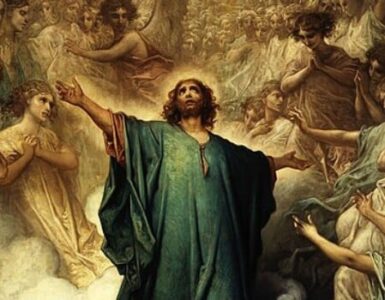You may have been taught at some point in school that most stories follow a basic structure. Beginning, middle, end. Exposition, rising action, climax, falling action, conclusion.
You may also have heard of stories having different types of conflict: person versus person, or self, or society, or environment. These categories point to the fact that every story involves some form of relationship.
The Christian view of history also involves a story structure, which describes the arc of history in terms of God’s relationship with humanity. The Gospel, or “Good News,” is essentially belief in a story.
As a Catholic who consumes a lot of fiction, I gradually noticed a pattern existing in most stories, present across times and cultures, that reflects aspects of the Gospel story structure. The pattern I see goes like this: there is an initially positive relationship; the relationship is broken through a breach of trust or responsibility; one of the parties attempts to repair the relationship; a death and resurrection take place; the relationship is restored, and perhaps becomes even better than before.
The Original Relationship
In the backstory or beginning of the narrative, there is a harmonious relationship. It might be between individuals, or it might encompass entire families, communities, nations, planets, or planes of reality.
In the Abrahamic religions, this part of the story is the creation of the world, the garden of Eden, and our first parents. Adam and Eve lived in right relationship with God, with each other, and with nature.
At some point, however, the harmony is interrupted, and the relationship breaks down. This is usually due to a mistake, failure, or betrayal. It could also be a death or some other tragedy. However the breakdown plays out, it has deep and lasting consequences. Trust is broken, the parties are alienated, and others can feel the ripple effects. In folklore and fiction, this is when Psyche betrays Cupid, when Claudius kills King Hamlet, when Scar kills Mufasa, when Maui steals the heart of Te Fiti.
In the Bible, this is when Adam and Eve break God’s commandment and eat the forbidden fruit. Their relationship loses its innocence as they realize they are naked—in other words, vulnerable to being misused and hurt. Instead of feeling safe and loved, they feel they must protect themselves from each other and hide themselves from God. As a result of their transgression, sin enters the world, and human beings are cast out of Paradise and must work the land in order to survive.
It is important to understand that Adam and Eve were not the only ones who suffered for their actions. All of creation likewise fell from the original state of innocence and happiness. Sin causes human beings live to at odds with God, with each other, and with the natural world.
This kind of micro-macro dynamic is apparent in many folktales and fantasy stories, where characters may be deities who embody an aspect of nature, or monarchs responsible for many people. In such cases, the state of the relationship is reflected on a larger scale in their environment. When the prince is transformed into a beast, or the princess falls under a sleeping curse, or the queen loses control of her ice powers, the people around them suffer along with them. Any iteration of the myth of Hades, Persephone, and Demeter will show this, as their relationships determine the cycle of the seasons. In Star Wars, Anakin Skywalker’s transformation into Darth Vader directly parallels the Galactic Republic’s transition to the Empire. The family dramas of such archetypal characters are reflected in the cosmic conflicts of their stories.
The relationship may experience ups and downs, but if there is any interaction or reunion, it remains imperfect and incomplete. Eventually, one of the parties must take the initiative to try to repair the relationship.
The Journey
In order to restore the relationship, one of the parties must go on a journey, often with a downward or inward direction. The protagonist enters another world, usually characterized by darkness and death. The Greeks called this part of their myths katabasis, the journey to the Underworld, the land of the dead. But this place can also be a place of meeting, reckoning, and revelation.
The Incarnation of Christ and the Harrowing of Hell can both be seen in this step. Jesus descended twice, first by leaving Heaven to be incarnated as a human being on Earth, and then, after His own death, by going to Hell and freeing the souls of the just who had died before His paschal sacrifice.
Many contemporary heroes have a similar step on their quest. Star Wars media is replete with examples of this, the first and most iconic being the Death Star. In more recent Disney films, Anna enters the ice palace to talk to her estranged sister, and Moana sets out to restore the heart of Te Fiti.
This journey presents great risks. In some cases, the protagonist must confront death itself, either as the power keeping their beloved from them, or in the form of the beloved themselves. Obi-Wan Kenobi in A New Hope, Luke Skywalker in Return of the Jedi, Anna, and Moana all know that the person they are approaching is dangerous and might harm them. Christ, too, knew that He would suffer at the hands of the very people He came to save.
Remembrance and Rejection
Throughout the story, there is often an element of trying to remember or discover one’s identity, or one party trying to make the other party aware of their true identity. This is a recurring theme in Scripture, as God’s prophets urge His people to remember who He is and who He has called them to be.
This theme is common in movies too. Luke Skywalker is determined to remind Darth Vader of his former identity. Mufasa’s ghost urges the self-exiled Simba, “Remember who you are.” Anna reminds Elsa of how close they were as children. Moana sings to the rampaging deity, “This is not who you are. I know who you are.”
At the moment of meeting, there might be a rejection of the identity or relationship. The prophets leading up to Christ were rejected and sometimes killed by their own people. He knew that not all would acknowledge Him when He came in person.
One possible reason for this rejection is that the lost party may not realize that they are lost. At the other extreme, they may recognize that they are lost, but think that they are beyond hope. Both of these attitudes are essentially a form of arrogance, which leads them to reject the call to remembrance and reconciliation.
Resurrection and Restoration
The meeting leads to the climax, which involves some kind of death, either literal or symbolic. There may also be a second betrayal, possibly even greater than the first. There is often an element of sacrifice and an appearance of loss or failure. Ultimately, though, the death leads to a kind of resurrection or rebirth.
When Christ came to restore humanity’s relationship with God, the people responded by killing Him. But His death led to His Resurrection, defeating death and making His identity clear to His followers.
This is also a moment of revelation, when one or both parties realize who they are and what they mean to each other. Christ’s disciples did not fully understand His divine identity, or the magnitude of His love for them, until He died on the cross and rose from the dead. The revelation can be a moment of horror—for instance, upon witnessing the supernatural events surrounding the death of Christ, the centurion declared that He was truly the Son of God. For examples in film, Darth Vader did not know he still had a capacity for love until he saw his son suffering out of love for him, and Elsa did not understand her sister’s love for her until Anna sacrificed herself to save her.
With the climax comes the reversal of the curse, the lifting of the exile, the restoration of the relationship. When the royal family is restored, the kingdom in turn is renewed. Anakin Skywalker reconciles with his son at the same moment the galaxy is freed from the Empire. Elsa’s openness to love enables her to thaw the snow in Arendelle. Te Fiti lifts the blight from Moana’s island home. Persephone’s travel plans ensure the return of spring.
Adoptions, marriages, coronations, or political alliances ensure the continuation and stability of a family, a dynasty, a nation, or an entire world. Likewise, Christ’s sacrifice sealed the New Covenant in His blood; His ministry established the Church on Earth; and the Bible ends with the Wedding Feast of the Lamb.
Author’s Note: I plan to further explore this pattern—as well as why it exists, and why it matters to us as media consumers—in my new podcast and blog, Finding Faith in Fandoms. I hope you will join me on this journey!










